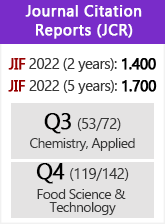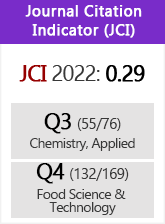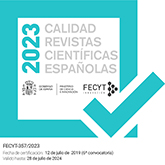Antioxidant activity, total phenolic, and total flavonoid of extracts from stems of Jasminum nervosum Lour
DOI:
https://doi.org/10.3989/gya.066810Keywords:
Antioxidant activity, Free radical scavenger, HPLC, Jasminum nervosum Lour, Total flavaonoid and total phenolicAbstract
Guangxi traditional Chinese Medical University Universidad de Medicina Tradicional China de Guangxi This study evaluated the antioxidant activities of the extracts of Jasminum nervosum Lour. stems along with the effects of different extract solvents on total phenolics (TP), total flavonoids (TF), and antioxidant potential. The antioxidant activity of the extracts was assessed using the following methods: DPPH, ABTS+ both free radicals scavenging assays, and reducing assays. TP and TF were detected by spectrophotometric and HPLC methods. In former methods, the highest amount of TP content was ethy lacetate extract (EAE), expressed as gallic acid equivalents. The greatest TF content was in the n-butanol extract (BE), expressed as lutin equivalents. No significant difference was observed in the TP/TF content between these two extracts. The antioxidant activity and TP/TF content of three extracts seemed to follow the same trend. This implied that there is a good correlation between antioxidant activities and TP/TF content. But in HPLC methods, EAE contained the highest content of lutin and gallic acid, which decreased in the same order of EAE > BE > PE, the rank order of TP/TF content of EAE and BE were different according to antioxidant ability. The overall results showed that the EAE and BE were richer in phenolics and flavonoids than petroleum ether extract (PE), and may represent a good source of antioxidants.
Downloads
References
Bushra S, Farooq A, Muhammad RA, Shahzad ASC. 2008. Antioxidant potential of extracts from different agro wastes: Stabilization of corn oil. Grasas y Aceites, 59, 205–217.
Dewanto V, Wu X, Adom K K, Liu R H. 2002. Thermal processing enhances the nutritional value of tomatoes by increasing total antioxidant activity. J. Agric. Food Chem. 50, 3010–3014. doi:10.1021/jf0115589 PMid:11982434
Editorial committee of the National Chinese Medicine Administrative bureau. 2005. Chinese materia medica. Shanghai Scientific and Technical Education Publishing House, Shanghai.
Halliwell B, Grootveld M. 1987. The measurement of free radical reactions in humans. FEBS Lett. 213, 9–14. doi:10.1016/0014-5793(87)81455-2
Jin W, Jan GF. 2006. Biological activities of iridoids, Herald of Medicine., 25, 530–533.
Li H, Hao Z, Wang X, Huang L, Li J. 2009. Antioxidant activities of extracts and fractions from Lysimachia foenum-graecum Hance. Bioresour Technol. 100, 970–974. doi:10.1016/j.biortech.2008.07.021 PMid:18793841
Ku CS, Mun S P. 2007. Antioxidant activities of ethanol extracts from seeds in fresh Bokbunja (Rubus coreanus Miq.) and wine processing waste. Bioresour Technol. 99, 2852–2856. doi:10.1016/j.biortech.2007.06.005 PMid:17656085
McDermott JH. 2000. Antioxidant nutrients: current dietary recommendations and research update. J. Am. Pharm. Assoc. 40, 785–799
Mohammad AE, Seyed FN, Seyed MN, Bahman E. 2010. Antihypoxic and antioxidant activity of Hibiscus esculentus sedes. Grasas y Aceites, 61, 30–36. doi:10.3989/gya.053809
Othman A, Ismail A, Ghani AN, Adenan I. 2007. Antioxidant capacity and phenolic content of cocoa beans. Food Chemistry 100, 1523–1530. doi:10.1016/j.foodchem.2005.12.021
Oyaizu M. 1986. Studies on product of browning reaction prepared from glucose amine. Jpn. J. Nutr. 44, 307–315.
Ozsoy N, Can A, Yanardag R, Akev N. 2008. Antioxidant activity of Smilax excelsa L. leaf extracts. Food Chemistry 110, 571–583. doi:10.1016/j.foodchem.2008.02.037
Paganga G, Miller N, Rice-Evans CA. 1999. The polyphenolic content of fruit and vegetables and their antioxidant activities. What does a serving constitute?. Free Radical. Res. 30, 153-162. doi:10.1080/10715769900300161 PMid:10193583
Re R, Pellegrini N, Proteggente A, Pannala A, Yang M, Rice Evans C. 1999. Antioxidant activity applying an improved ABTS radical cation decolorization assay. Free Radic. Biol. Med. 26, 1231–1237. doi:10.1016/S0891-5849(98)00315-3
Sasak YF, Kawaguchi S, Kamaya A, Ohshita M, Kabasawa K, Iwama K, Taniguchi K, Tsuda S. 2002. The comet assay with 8 mouse organs: Results with 39 currently used food additives. Mutation Research/ Genetic Toxicology and Environmental Mutagenesis. 519, 103–119. doi:10.1016/S1383-5718(02)00128-6
Shimada K, Fujikawa K, Yahara K, Nakamura T. 1992. Antioxidative properties of xanthan on the antioxidation of soybean oil in cyclodextrin emulsion. J. Agric. Food Chem. 40, 945–948. doi:10.1021/jf00018a005
Slinkard K, Singleton VL. 1977. Total phenol analyses: automation and comparison with manual methods. Am. J. Enol. Vitic. 28, 49–55.
Tevfik Özen. 2010. Antioxidant activity of wild edible plants in the Black Sea Region of Turkey. Grasas y Aceites, 61, 86–94. doi:10.3989/gya.075509
Downloads
Published
How to Cite
Issue
Section
License
Copyright (c) 2011 Consejo Superior de Investigaciones Científicas (CSIC)

This work is licensed under a Creative Commons Attribution 4.0 International License.
© CSIC. Manuscripts published in both the printed and online versions of this Journal are the property of Consejo Superior de Investigaciones Científicas, and quoting this source is a requirement for any partial or full reproduction.All contents of this electronic edition, except where otherwise noted, are distributed under a “Creative Commons Attribution 4.0 International” (CC BY 4.0) License. You may read here the basic information and the legal text of the license. The indication of the CC BY 4.0 License must be expressly stated in this way when necessary.
Self-archiving in repositories, personal webpages or similar, of any version other than the published by the Editor, is not allowed.
















